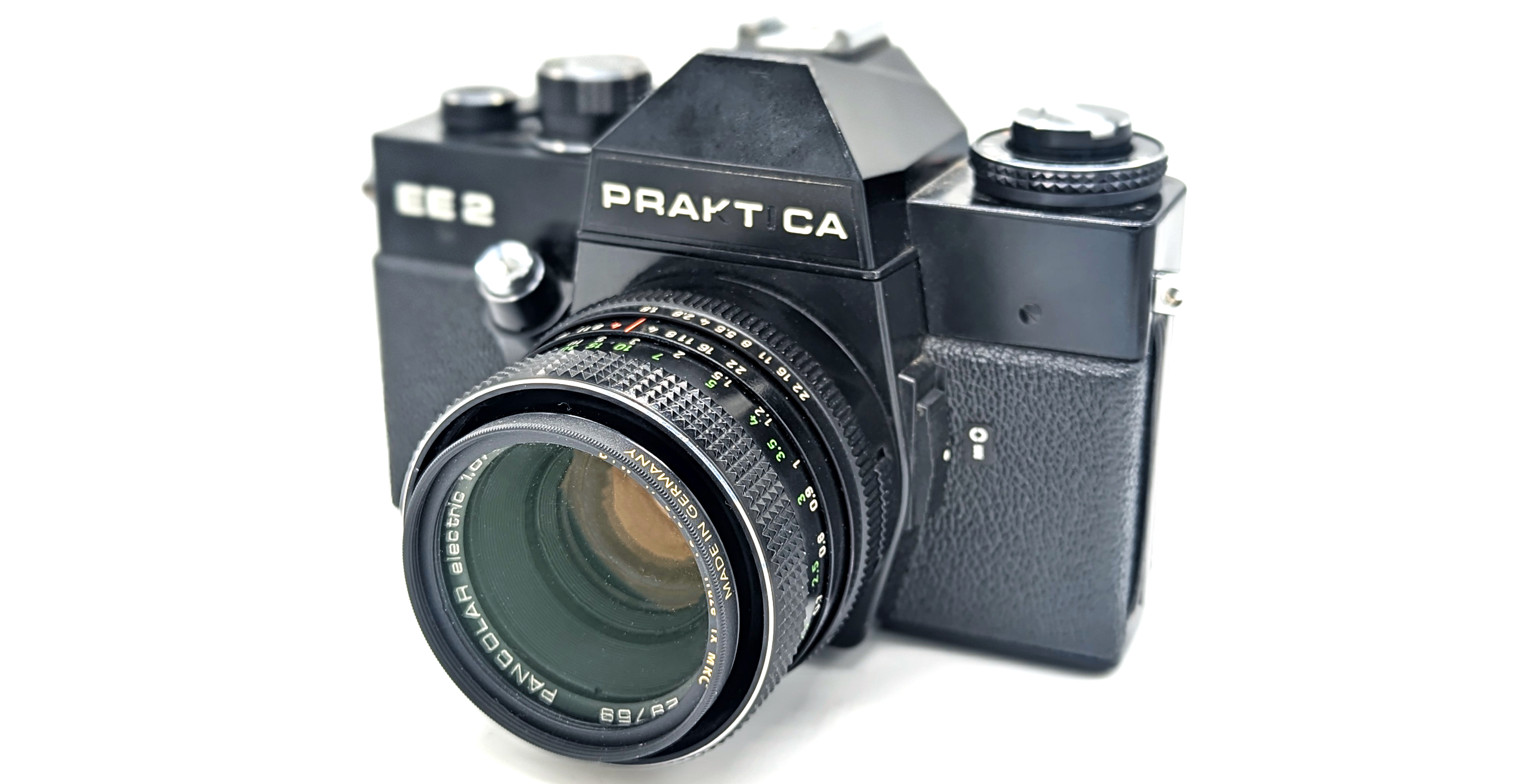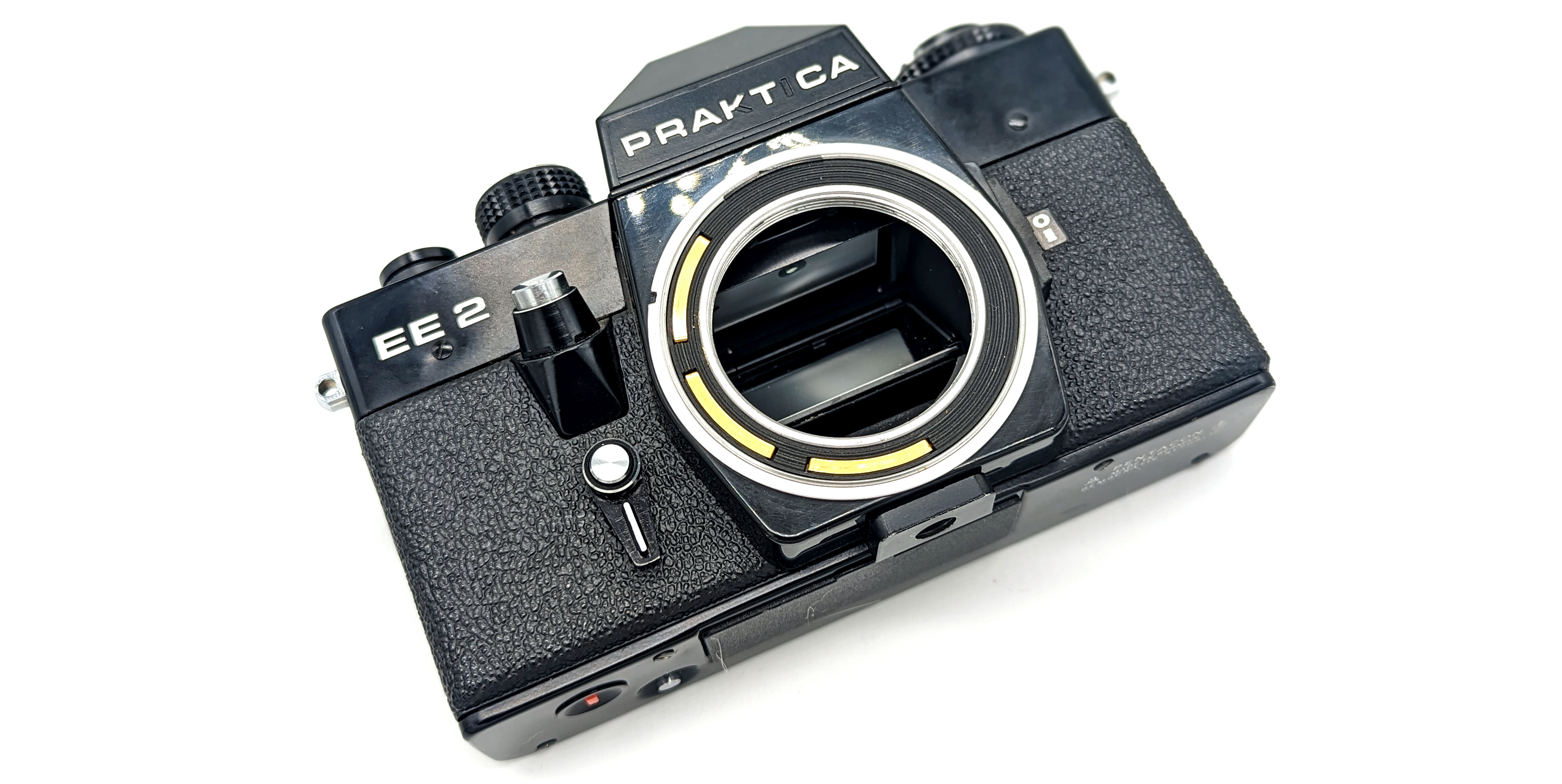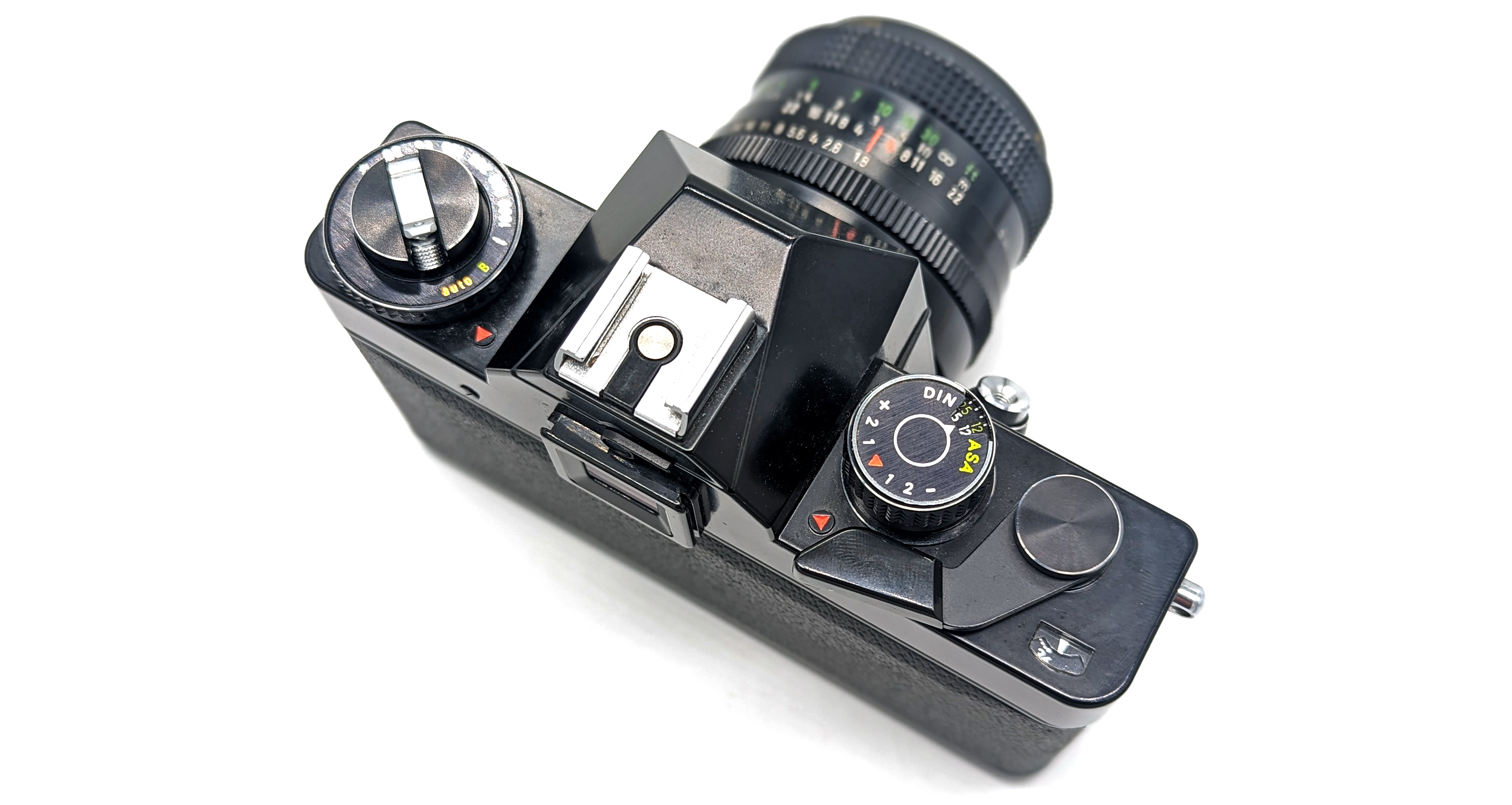
The 1977 Praktica EE2 (and the “praktically”-identical 1979 EE3) was the most advanced M42 SLR camera body produced by Pentacon. The EE2’s run was ultimately cut short as Praktica introduced its next generation bayonet mount cameras in 1979. If you are a fan of East German M42 lenses and enjoy the convenience of aperture-priority autoexposure, is the EE2 a model worth considering? Maybe, but only if you primarily use East German “Electric” lenses. It is not a particular great all-around M42 lens platform.
During 1969, Praktica introduced the “LLC,” a member of the fourth generation of M42 camera bodies. These cameras no longer required a two-step “stop down” operation for TTL light metering. With extra linkages added between lens and the body, the lens could communicate the selected aperture to the camera’s meter without the lens having to physically stop down to read the lighting. In Praktica’s case, only East German “Electric” M42 lenses (those with the electrical contacts on the body) would work with this open-aperture metering system. The LLC and its direct descendants did not have true “autoexposure,” and still required the user to set both the shutter speed and aperture via a “match-needle” visual aid in the camera’s viewfinder.
During 1971, Pentax was the first M42 camera manufacturer to announce a true aperture-priority autoexposure camera. The fifth generation of M42 camera bodies also required proprietary M42 lenses. Several other companies followed with autoexposure models such as the Fujica ST901 and the Ricoh Auto TLS EE.
During 1977, Pentacon announced the Praktica EE2, its first electronic shutter camera body capable of aperture-priority autoexposure. The later 1979 EE3 would only add a split-image focusing screen. The EE2 did not hit the North American market until mid-to-late 1978 and was advertised for around $250 with a Pentacon 50mm f/1.8 lens. Besides the standard Pentacon lens, it is unclear what range of East German M42 “Electric” lenses even existed in the North American market during this time. During this time, most American retailers offered generic, Japanese-made M42 lenses in the 28mm, 135mm, and 200mm focal lengths that would require the two-step “stop down” metering to work correctly on the EE2.
These days, the EE2 is a relatively affordable and fairly capable M42 camera body. The example I acquired worked for a while then the electronics went haywire and ultimately could not be repaired. If you are a fan of 1970s East German M42 lenses, is it worth it? Let’s take a look.

Comparison With Other Contemporary Praktica Electric M42 Bodies
Here are three post-LLC “Electric” Praktica bodies compared. The later EE3, VLC3, and PLC3 were the same as their predecessors but for the addition of split-image focusing screen.
| EE2 | VLC2 | PLC2 | |
| Years Introduced | 1977 | 1976 | 1975 |
| M42 Generation | 5th | 4th | 4th |
| Shutter Speeds | B, 1 sec – 1/1000 (Stepless) | B, 1 sec – 1/1000 | B, 1 sec – 1/1000 |
| Shutter | Electronic | Mechanical | Mechanical |
| Battery | V21PX | V21PX | V21PX |
| Flash Sync Speed | 1/125 | 1/125 (No Hot Shoe) | 1/125 |
| Prism | Fixed | Removable | Fixed |
| Viewfinder Information | Shutter Speeds | Match Needle | Match Needle |
| Focusing Screen | Microprism | Microprism | Microprism |
| ASA Range | 12-1600 | 12-1600 | 12-1600 |
| Autoexposure? | Yes | No | No |
| Exposure Compensation | + / – 2 stops | No | No |
| Work Without Battery? | No | Yes | Yes |
| Exposure Lock? | No | No | No |
East German “Electric” Lenses
The German “Electric” M42 lenses for the Praktica system included the following.
| Manufacturer | Lens | Elements/Groups | Min. Focus | Filter Thread |
| Carl Zeiss Jena | 20mm f/2.8 Flektogon | 9/8 | 0.19m | 67mm |
| Pentacon | 29mm f/2.8 | 7/7 | 0.25m | 55mm |
| Carl Zeiss Jena | 35mm f/2.4 Flektogon | 6/6 | 0.20m | 49mm |
| Schneider Kreuznach | 35mm f/2.8 Curtagon | 6/5 | 0.30m | 49mm |
| Carl Zeiss Jena | 50mm f/1.8 Pancolar | 6/5 | 0.35m | 49mm |
| Pentacon | 50mm f/1.8 | 6/4 | 0.33m | 49mm |
| Carl Zeiss Jena | 80mm f/1.8 Pancolar | 6/5 | 0.80m | 58mm |
| Pentacon | 100mm f/2.8 | 5/4 | 1.10m | 49mm |
| Pentacon | 135mm f/2.8 | 5/4 | 1.50m | 55mm |
| Carl Zeiss Jena | 135mm f/3.5 Sonnar | 4/3 | 1.00m | 49mm |
| Schneider Kreuznach | 135mm f/3.5 Tele Xenar | 5/5 | 1.50m | 49mm |
| Carl Zeiss Jena | 200mm f/2.8 Sonnar | 6/4 | 2.20m | 77mm |

Operation
The EE2 has decent functionality for mid-range 1977 camera body. The most important feature omitted from all M42 Praktica bodies was the lack of an exposure lock, which would not arrive on a Pentacon product until the bayonet-mount B200 in 1979.
Viewfinder: The EE2 has average viewfinder brightness for this class of camera. Although the EE2 came with a microprism focusing screen, at least some models seem to have been equipped with a split-image screen (maybe export models?). The focusing screen and prism certainly could have been much better. The shutter speeds are displayed on the right of the viewfinder screen with a needle indicating the speed at the selected aperture. A half-press of the front-mounted shutter button will turn on the meter.
Shutter Speeds: The EE2 uses a stepless, electronically-controlled shutter that requires a battery to operate. The “A” setting is for autoexposure but manual speeds can be selected. Like many Pentacon products of the era, the angled shutter button is located on the front of the camera and takes a standard cable release. The shutter noise itself is not pleasant.
“Electric” Lenses: The Praktica “Electric” system is unique for M42 open-aperture focusing/metering as it uses electrical contacts on the lens mount rather than proprietary mechanical linkages like other manufacturers. With electric lenses, the aperture is always held open for focusing but the lens will meter at the aperture selected on the lens and will stop down when a shot is taken. Via a switch on the right side of the lens mount, you can use other automatic diaphragm M42 lenses in “stop down” metering mode.
Battery: The LLC / VLC / PLC / EE series originally used a single mercury 4.5V battery which is no longer available. There are several modern solutions. The first is an alkaline A21PX. The second is a battery adapter available that permits the use of three 1.5V SR44 batteries. The EE2, like other contemporary Praktica cameras, has a noticeably flimsy plastic cover for the battery at the bottom of the camera.
Exposure Compensation: While none of the Praktica M42 camera bodies have an exposure lock function, the EE2 does permit at +/- 2 stop exposure compensation via a dial on the top of the camera.
Flash: The EE2 does not have any sophisticated flash functionality, and its flash sync is 1/125. To use the flash sync, one must manually select the lightning bolt on the shutter speed dial.
Other Functions: The EE2 has a standard self-timer lever, the stop down lever for metering with non-Electric M42 lenses, the ability to close the viewfinder to prevent the entry of stray light, a battery check button on the bottom of the camera.
Accessories
Other than a case, the EE2 did not have any significant, camera-specific accessories.
Conclusion
The EE2 was one of only a handful of M42 electronic shutter, aperture-priority autoexposure cameras produced during the 1970s. As a platform for East German “Electric” lenses, it is pretty good only to the extent that it provides aperture-priority autoexposure, but otherwise it is not an extraordinary product. As a platform for other M42 lenses, it is very average, not offering any capability or advantage over any other third or fourth generation body. When compared to other Prakticas of the era, the EE2 is certainly more advanced than the mechanical-shutter PLC, VLC, or MT series. As with any 45 year-old film camera, many EE2s may be DOA and/or may need some work. I would also suggest looking for the rarer EE3 as the former’s split-image focusing screen can be much easier to use.
There was also a Sigma-made Pentacon Electric 39-80mm f/3.5 zoom offered. As with many automatic M42 SLRs, the manual mode of the EE2/EE3 is unmetered.